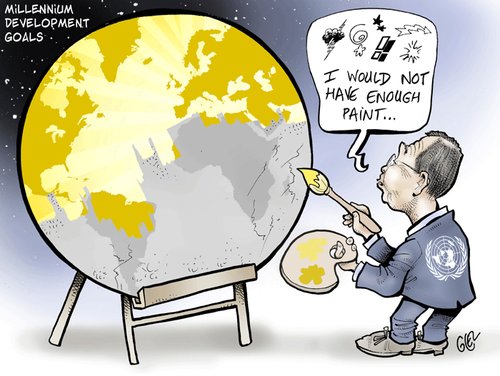Ever since the Second World War, several aid programs for the Third World have been called into existence. Most of these initiatives can hardly be called a success. This failure of development aid is partially due to the creative exploits made by the industrialized North. Indeed a lot of misuses exist and today's objective is to expose them.
DEFINING AID
Most important is to give a proper definition of what development aid is. The accepted standard is the 'Official Development Assistance' (ODA) as put forth by the OECD countries. A lot of spending included in ODA is highly controversial. For instance, up till 1990 it was allowed to book military aid as development assistance. Just think of all the 'developing' the United States have done in the Vietnam War... Less striking examples of such misfits include the administrative costs a country makes to deliver aid and the costs attached to the first year of shelter for refugees and asylum seekers. All these positive reductions contribute to a higher number of delivered aid while the benefits for development remain a mystery.
 |
| Military assistance is NOT development aid (or is it?) |
Another curiosity is the inclusion of humanitarian aid; the kind of emergency aid raised to combat the results of a natural disaster or a food crisis. This is not development aid in a strict sense, yet it was good for almost one tenth of all ODA donated in 2008. My personal favorite amongst the ODA misfits is however debt remission. In 2008, debt remissions made up a staggering 28% of all ODA. While it is true that debt remission lightens the burden that lays on a country it remains an exploit due to the way it is used. The instrument of debt remission is addressed only to avoid default and to keep countries borrowing.
A NOBLE GESTURE
So far for cheating trough accountancy. Up to another sore now: the motives for aid. Why is it that developed countries allocate part of their wealth to the not-so-wealthy? It will not surprise you that 'contributing to a better world' is not the main incentive. A most effective way to make motives for aid visible is to take a look at who is receiving it. If development really was the goal one could expect ODA to flow mainly to the Least Developed Countries (LDC's). Yet a lot of financial means are dedicated to middle-income countries. Between the lines you may read that donor countries subsidize the local purchasing power to the benefit of their own export.
 |
| Is world-wide development even possible? |
A more explicit manifestation of economic motives is the so-called 'tied aid'. This is to be understood as ODA given under the condition that the money is spent on purchases in the donor country. Old-fashioned and vulgar subsidizing. It is sound to assume that this type of aid will be applied least in the LDC's as their purchasing power is lowest. Figures show that in 2005 almost half of the ODA destined for LDC's was tied aid.
Next to economic motives, geopolitics are an important factor too. At the end of the Cold War, in 1991, Egypt and Israel had a joint share of 41% in the development assistance provided by the United States. Inescapable in this light is the war on terror which provided a new boost for geopolitically motived aid. In the period 1999-2003, means donated by OECD countries to Pakistan increased tenfold. In 2009 Afghanistan and Iraq were the biggest receivers of US paychecks.
CONCLUSION
The facts and figures displayed in this post show a grim image of development aid. Numerous multilateral efforts have been made to correct the highlighted mistakes, but to no avail. My prediction is that until 2015 - the end date for the fulfillment of the Millennium Development Goals - governments will continue as they are. In little over three years time they will come to the conclusion that it didn't work out quite as they planned. But we ought to be confident that civil organizations will remind them; that they will point out their mistakes. And just maybe 2015 can be the start of a new practice of actual development.

Geen opmerkingen:
Een reactie posten